Why Modern Morgue Storage Solutions Are Critical for Today's Facilities
Morgue storage solutions are specialized equipment systems designed to maximize space efficiency, ensure dignified handling of deceased individuals, and provide surge capacity during emergencies. These solutions include multi-tier cadaver racks, refrigerated mortuary cabinets, collapsible temporary structures, and mobile storage units that can increase facility capacity by up to 400%.
Key Types of Morgue Storage Solutions:
- Fixed Cadaver Racks - Stationary multi-tier systems (2-5 tiers) supporting 300-500 lbs per tier
- Mobile Rack Systems - Wheeled units for flexible workflow and space reconfiguration
- Collapsible Emergency Racks - Deploy in 60 seconds for surge capacity needs
- Refrigerated Cabinets - Traditional units storing 1-15 bodies with integrated cooling
- Temporary Structures - Pop-up domes and ISO containers for mass fatality events
The funeral industry has experienced unprecedented storage demands since 2020. During the COVID-19 pandemic, emergency response teams deployed 298 MERC systems nationwide with capacity for 7,500 remains. A single 4-tier cadaver rack can quadruple storage capacity in the same floor space compared to single-level storage.
Modern morgue storage solutions address three critical needs: space efficiency, staff safety, and emergency preparedness. The bottom shelf height of 40cm allows standard trolley use, dramatically reducing staff injuries from manual lifting.
I'm Mortuary Cooler, and as a national-level supplier of morgue storage solutions, I've helped facilities across America optimize their storage capacity while maintaining dignity and safety standards.
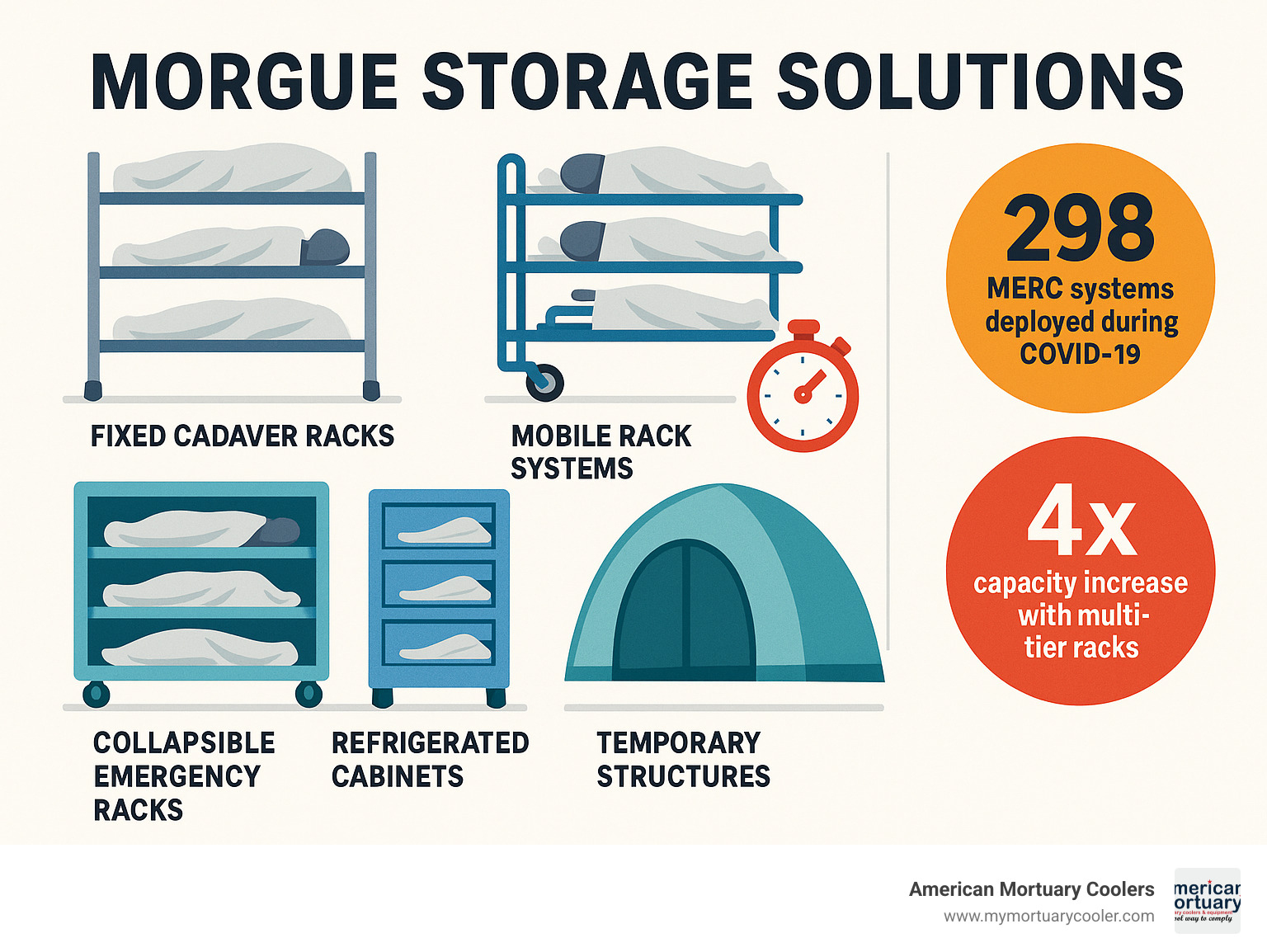
Morgue storage solutions terms simplified:
Overview of Modern Morgue Storage Solutions
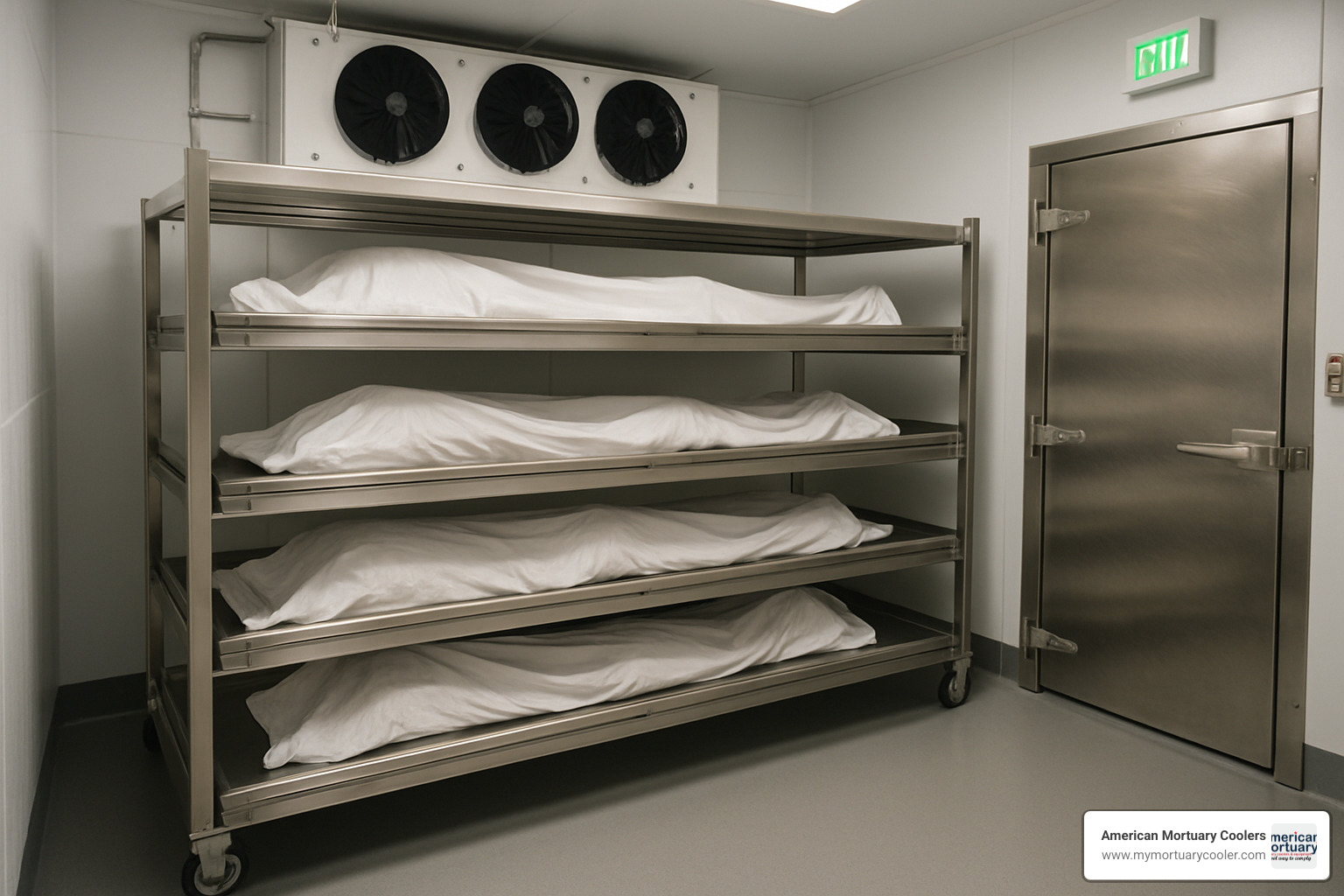
Modern morgue facilities have evolved significantly from basic refrigerated cabinets. Today's morgue storage solutions combine smart engineering with genuine care for both the deceased and professionals who serve them.
With 47 companies offering 232 different mortuary cabinet products, the industry recognizes that one size doesn't fit all. Understanding the five main categories of modern storage solutions makes choosing the right system clearer.
Main Types of Morgue Storage Solutions
Fixed racks serve as reliable workhorses of morgue storage. These stationary systems, like the CSI Jewett SR1556 cantilever rack, anchor your facility's storage capacity. They can be assembled on-site without welding, allowing customization for exact space requirements.
Mobile racks bring flexibility to facilities needing quick adaptation. These wheeled systems allow rolling entire storage units for deep cleaning or layout rearrangement, though safety protocols require emptying before moves.
Collapsible racks become lifesavers during emergencies. The Flexmort Collapsible Temporary Rack assembles in 60 seconds without tools - a capability disaster response teams call a "game-changer."
Refrigerated cabinets offer all-in-one solutions many smaller facilities prefer. These units combine cooling and storage, ranging from compact 2-body units to large cold rooms accommodating over 100 deceased. Modern versions feature SmartProtec® antimicrobial finishes and 80mm high-density polyurethane insulation.
Pop-up domes and temporary structures provide rapid deployment for surge capacity. The Mobile Mortuary Dome inflates in 20 minutes and accommodates up to 56 deceased - expandable to over 200 with modular units. ISO container mortuaries offer secure storage for up to 60 deceased per unit.
How Morgue Storage Solutions Multiply Capacity & Streamline Workflow
A 4-tier rack system can quadruple storage capacity in the same floor space. The standardized 40cm bottom shelf height works perfectly with standard mortuary trolleys, eliminating back-breaking manual lifting that has plagued mortuary workers.
Roller assemblies allow bodies to be transferred with minimal effort - creating what one manager called "gravity-free" transfers. Modern racks incorporate thoughtful details like large A4 identification pockets and security straps for safe transport while maintaining dignity throughout the process.
Cadaver Rack Systems: Design, Features & Benefits
| Feature | Fixed Racks | Mobile Racks | Collapsible Racks |
|---|---|---|---|
| Setup Time | 2-4 hours | 1-2 hours | 60 seconds |
| Capacity | 2,500 lbs total | 1,500 lbs total | 1,200 lbs total |
| Flexibility | Low | High | Highest |
| Stability | Highest | Medium | Medium |
| Cost | $3,000-8,000 | $4,000-10,000 | $2,000-5,000 |
Understanding the engineering behind cadaver rack systems makes all the difference when choosing morgue storage solutions. Each type serves specific needs, and smart facilities often mix different systems for optimal results.
Fixed, Mobile & Collapsible Rack Engineering
Cantilever design eliminates vertical supports that obstruct access. The Mopec IA Series cantilever rack supports up to 2,500 pounds total while keeping everything accessible from any angle.
Side-loading racks maximize tight spaces where every square foot matters. End-loading systems work best in rectangular rooms for maximum capacity. Multi-directional racks offer Swiss Army knife versatility for complex floor plans or teaching facilities.
Knock-down frames solve the problem of getting equipment through standard doorways. These modular systems ship efficiently, then assemble on-site without welding.
Material choice between stainless steel and powder-coated steel often comes down to budget versus durability. Stainless steel provides superior corrosion resistance and easier cleaning, while powder-coated options offer solid performance at lower cost.
Key Features that Matter
Weight ratings aren't just specifications - they're safety nets. Standard capacity tiers handle about 300 pounds each, while premium Mopec IA Series systems support 500 pounds per tier. For bariatric cases, specialized tiers rated for 750 pounds are becoming essential.
Screw-type leveling feet rated at over 7,000 pounds each provide rock-solid stability. More detailed information about rack specifications shows the engineering behind these components.
Roller assemblies are precision-engineered systems distributing weight evenly while providing smooth operation after thousands of loading cycles.
Safe & Ergonomic Handling Practices
Modern morgue storage solutions prioritize staff safety through smart engineering. Battery-powered scissor lifts eliminate back-breaking work, while hydraulic systems provide precise positioning control.
Two-finger transfer capability significantly reduces workplace injuries. The biggest breakthrough is bottom-shelf trolley access, eliminating the need to lift bodies from floor level - tackling the main cause of mortuary worker injuries.
Integrating Refrigeration, Surge Capacity & Custom Options
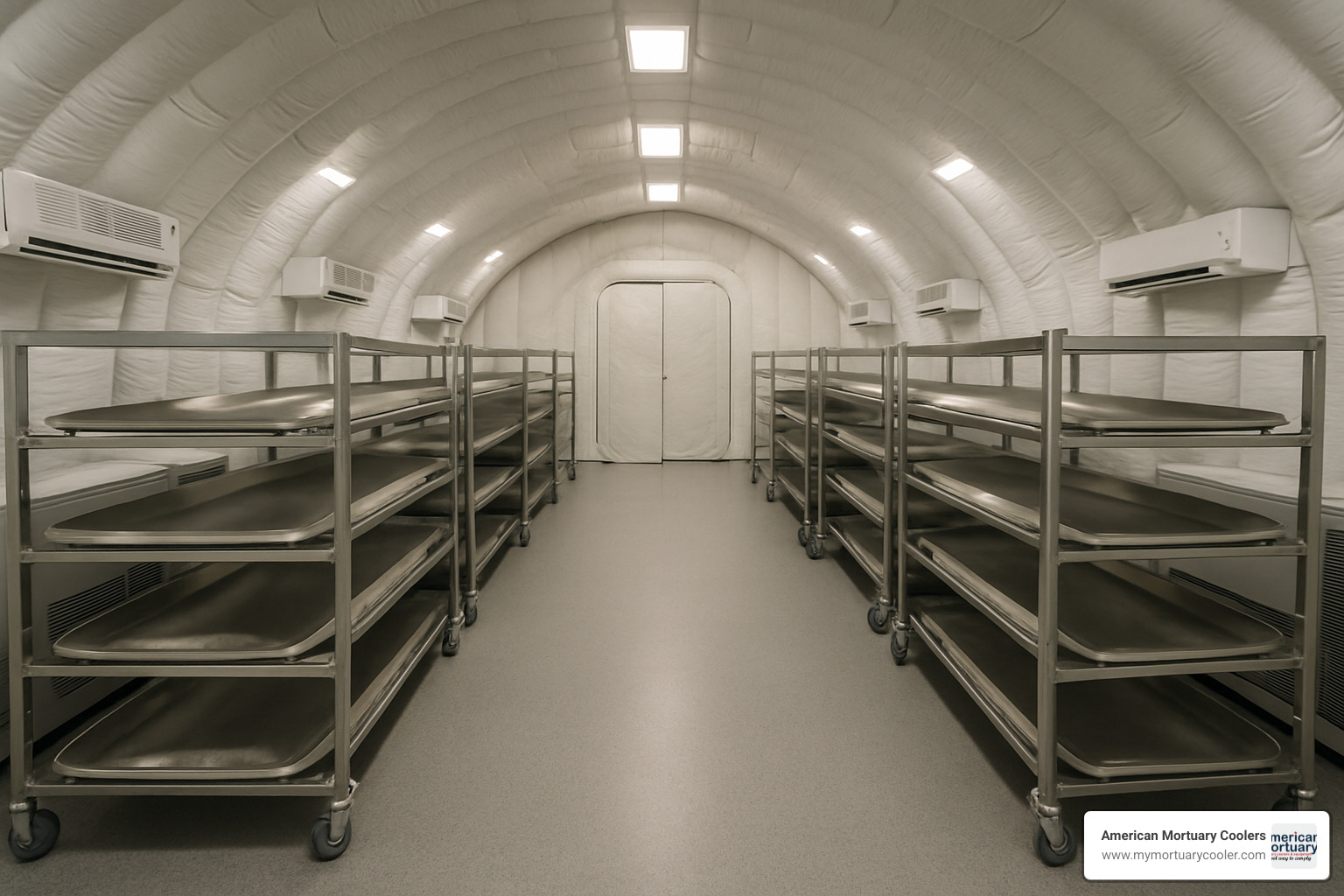
The real magic happens when morgue storage solutions work seamlessly with cooling systems. It's not just about keeping bodies cold - it's about creating a complete environment that maintains dignity while making your staff's job easier and safer.
Think of it like building a puzzle where every piece has to fit perfectly. Your storage racks need to work with your cooling system, your emergency plans, and your daily workflow. When done right, the whole system feels effortless.
Refrigeration Pairing & Thermal Performance
Getting the temperature right is more precise than most people realize. Morgue storage solutions need to maintain that sweet spot between 0-10°C, with most facilities aiming for 2-4°C. Too cold and you're dealing with frozen tissue complications. Too warm and you're racing against time.
Plug-and-play condensers have been a game-changer for facilities like yours. Instead of one massive cooling unit that sounds like a freight train, you can use multiple smaller units positioned away from your work areas. This means less noise, less heat in your workspace, and if one unit has issues, you're not completely out of commission.
The antimicrobial panels with SmartProtec® finishes actually fight bacteria on contact. It's like having a cleaning crew working 24/7 on your panel surfaces. Combined with 80mm high-density polyurethane insulation (including insulated floors), these systems maintain temperature with impressive efficiency.
Temporary Mortuary Structures take this integration concept and make it portable. Imagine having a complete morgue facility that you can set up anywhere you have power - that's the reality of modern integrated systems.
Surge & Emergency Morgue Storage Solutions
Nobody wants to think about emergencies, but smart facilities plan for 3-4× their normal storage capacity. The good news? You don't need to build a massive addition to your facility.
Pop-up AirCool systems are like the Swiss Army knife of emergency storage. Available in multiples of 4 (AirCool 4, 8, 12, 16, 24), these systems go from storage to fully operational cold room in minutes. The bariatric version handles individuals up to 256 kg (40 stone), so you're prepared for any situation.
ISO container solutions offer the security of a bank vault with the convenience of a shipping container. Each unit stores up to 60 deceased with integrated cooling plants. You can even retrofit existing containers to boost capacity and improve working conditions.
Inflatable domes sound futuristic, but they're very real and incredibly practical. The Mobile Mortuary Dome inflates in just 20 minutes and maintains temperature without constant air supply. Need more space? Connect multiple units to store over 200 bodies. The thermal insulation technology is described as "the lightest and most efficient of its type."
MERC trailers proved their worth during COVID-19, when 298 systems were deployed nationwide. These highway-transportable units can be at your location within hours, providing immediate relief when you need it most.
Customization for Bariatric & Coffin Storage
Every facility has unique needs, and modern morgue storage solutions adapt to handle everything from pediatric cases to bariatric individuals to full coffin storage.
Wider support arms for bariatric applications maintain all the ergonomic benefits while supporting individuals up to 256 kg. Your staff doesn't sacrifice safety or ease of use just because they're handling larger cases.
Coffin-specific shelving addresses the growing trend of earlier casketing. These systems accommodate standard casket dimensions while keeping those helpful roller-assisted loading features that save your staff's backs.
Adjustable tier systems give you the flexibility to reconfigure on the fly. Mixed caseload today? No problem. You can adjust spacing without needing completely different storage systems.
Security straps ensure everything stays safely in place during transport and storage. These integrated restraint systems prevent any shifting while maintaining easy access for identification and transfers. It's about maintaining dignity and safety at every step.
Selecting the Right Morgue Storage Solution for Your Facility
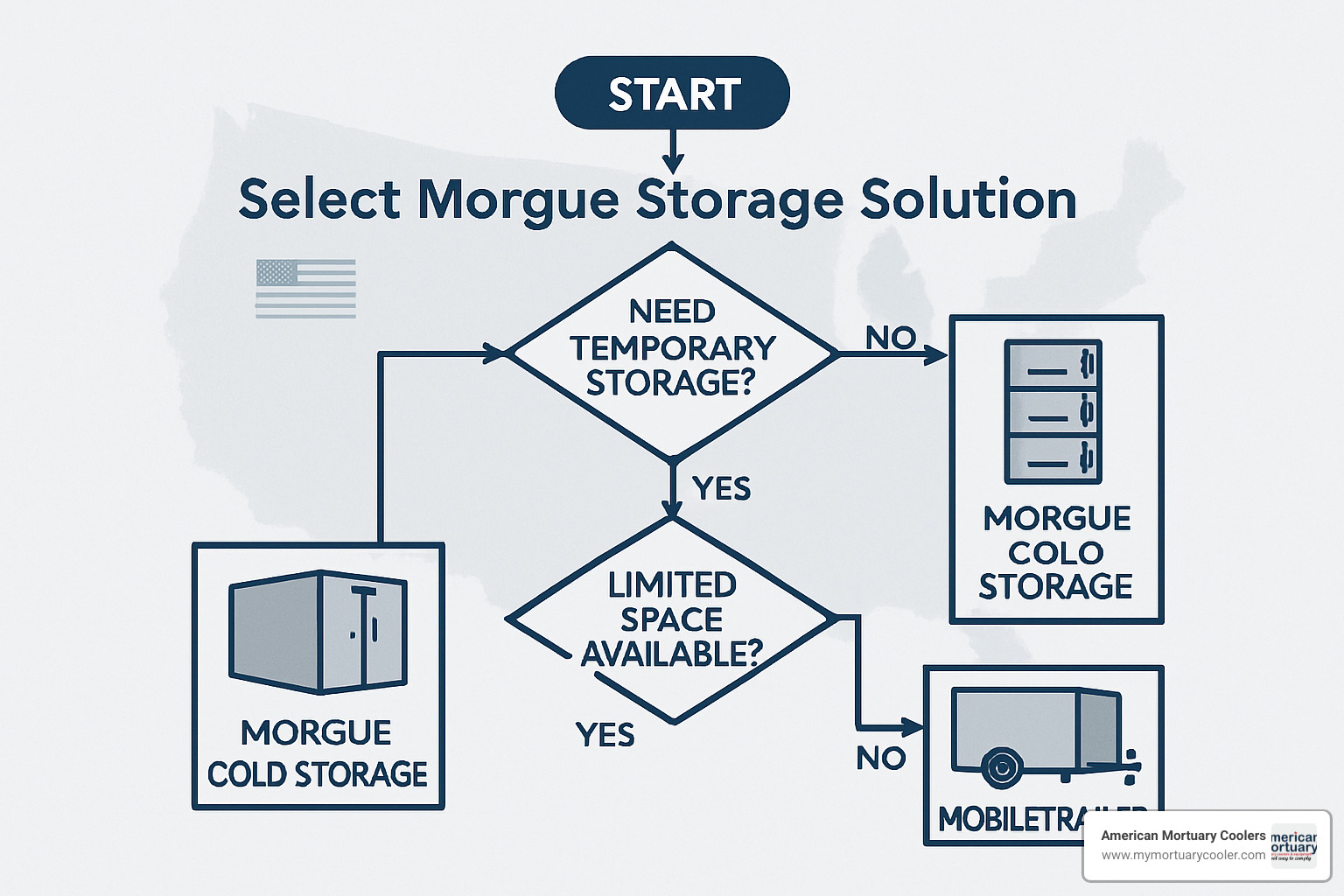
Choosing the right morgue storage solutions requires balancing budget, space, and compliance requirements. The best choice isn't always the most expensive - it's the one fitting your specific needs.
The Cold Storage 101: Morgue Freezer Racks Explained guide provides technical details, but here's what matters most for your decision.
Capacity, Weight Ratings & Tier Choices
3-4 tier systems typically hit the sweet spot between capacity and accessibility. While 5-tier systems maximize space, staff often struggle with top tier access. Two-tier systems work beautifully for facilities with lower ceilings or limited lifting equipment.
Width specifications matter significantly. 23-inch width works perfectly with standard mortuary trolleys, while 27-inch systems offer more flexibility but may not fit through some cooler doors. Always measure doorways first.
When calculating total loads, plan for a 20% safety margin above expected loads for systems rated at 2,500 pounds.
Mobile vs Stationary: Making the Call
Mobile systems offer incredible flexibility for reconfiguration, cleaning, and varying caseloads. Stationary systems provide maximum stability and typically higher capacity.
Workflow patterns determine the best choice. If your facility regularly needs rack movement, mobile systems make sense. For consistent storage areas prioritizing stability, fixed systems often work better.
Hybrid layouts combining both approaches work well - fixed racks for baseline capacity with mobile units for flexibility.
Cost, Maintenance & Regulatory Checklist
Basic 2-tier mobile racks start around $2,000, while premium 4-tier stainless steel systems range $5,000 to $8,000. Custom installations can exceed $10,000.
Material choice impacts upfront costs and maintenance. Stainless steel costs more initially but handles aggressive disinfectants without damage. Powder-coated systems cost less but need gentler cleaning products.
NFPA and OSHA compliance requirements vary by location. Check with local authorities before finalizing specifications.
Budget-Friendly Morgue Storage Solutions & Funding Tips
FEMA and state emergency management grants can cover 75-90% of equipment costs for facilities providing disaster response capabilities.
Rental versus purchase makes sense for seasonal variations or temporary surge needs. Knock-down shipping can save $500 to $1,500 in freight charges. Many systems allow in-house assembly by facility maintenance staff, eliminating contractor costs.
Frequently Asked Questions About Morgue Storage Solutions
When facilities are evaluating morgue storage solutions, three questions come up consistently in our conversations. Having helped funeral homes and medical facilities across the country, I've learned that getting clear, practical answers to these questions makes all the difference in choosing the right system.
What weight can each tier safely hold?
This is probably the most important safety question we get, and the answer depends on what type of system you're considering. Standard commercial cadaver racks handle about 300 pounds per tier, which works well for most situations you'll encounter day-to-day.
But here's where it gets interesting - premium systems like the Mopec IA Series bump that up to 500 pounds per tier. That extra capacity isn't just about handling larger individuals (though it certainly helps with that). It's about peace of mind and safety margins that protect both your staff and the families you serve.
For facilities dealing with bariatric cases regularly, specialized tiers can support up to 750 pounds, including the weight of trays and boards. This isn't just about meeting today's needs - it's about preparing for tomorrow's as well.
Here's something that surprises people: the math doesn't always add up the way you'd expect. Take that Mopec IA Series I mentioned - it supports 2,500 pounds total across 5 tiers, even though each tier is rated at 500 pounds. The engineering distributes the load in ways that actually strengthen the overall system.
How do morgue storage solutions integrate with refrigeration systems?
The beauty of modern morgue storage solutions is how seamlessly they work with different cooling setups. Whether you're working with a traditional walk-in cooler or considering one of the newer modular systems, proper integration is all about airflow and access.
In traditional walk-in coolers, positioning matters more than you might think. That 40cm bottom shelf height I've mentioned before? It's not just about getting trolleys underneath - it's about letting cold air circulate properly around the lowest tier. Good airflow means consistent temperatures and better preservation.
Modular cold rooms take integration to the next level. These cam-lock panel systems come with built-in cooling plants that work beautifully with various rack configurations. The SmartProtec® antimicrobial finishes on the panels actually complement the rack materials to keep everything hygienic.
The portable systems really show off what's possible when storage and cooling are designed together. AirCool units maintain 5°C internal temperature even when it's 40°C outside. The AirCool Extreme version proves that with the right insulation and cooling technology, you can create proper morgue conditions almost anywhere.
What are the cleaning and disinfection best practices?
Keeping your storage systems clean isn't just about following regulations - it's about maintaining dignity and respect while protecting your equipment investment. The good news is that modern systems are designed to make this easier than ever.
Stainless steel systems are the gold standard for cleaning. Start by removing any debris, then clean with mild detergent and warm water. After a thorough rinse, apply your hospital-grade disinfectant and let it do its work - most require a full 10-minute contact time. Some disinfectants need another rinse afterward, so check your product labels. Always let everything air dry completely before putting the system back into service.
Powder-coated systems need a gentler touch to protect that finish. Use milder disinfectants and wipe rather than spray to avoid pooling in corners and crevices. During each cleaning, take a moment to look for chips or scratches - catching damage early and touching it up prevents bigger problems down the road.
The roller assemblies deserve special attention because they're working hard every day. Clean them with brushes to get debris out of the moving parts, make sure they're completely dry to prevent bearing problems, and follow the manufacturer's lubrication schedule. Replace worn rollers before they start affecting smooth operation.
Most facilities find that weekly deep cleaning combined with cleaning between uses keeps everything in top condition while extending the life of their equipment. It's one of those investments in time that pays dividends in reliability and longevity.
Conclusion
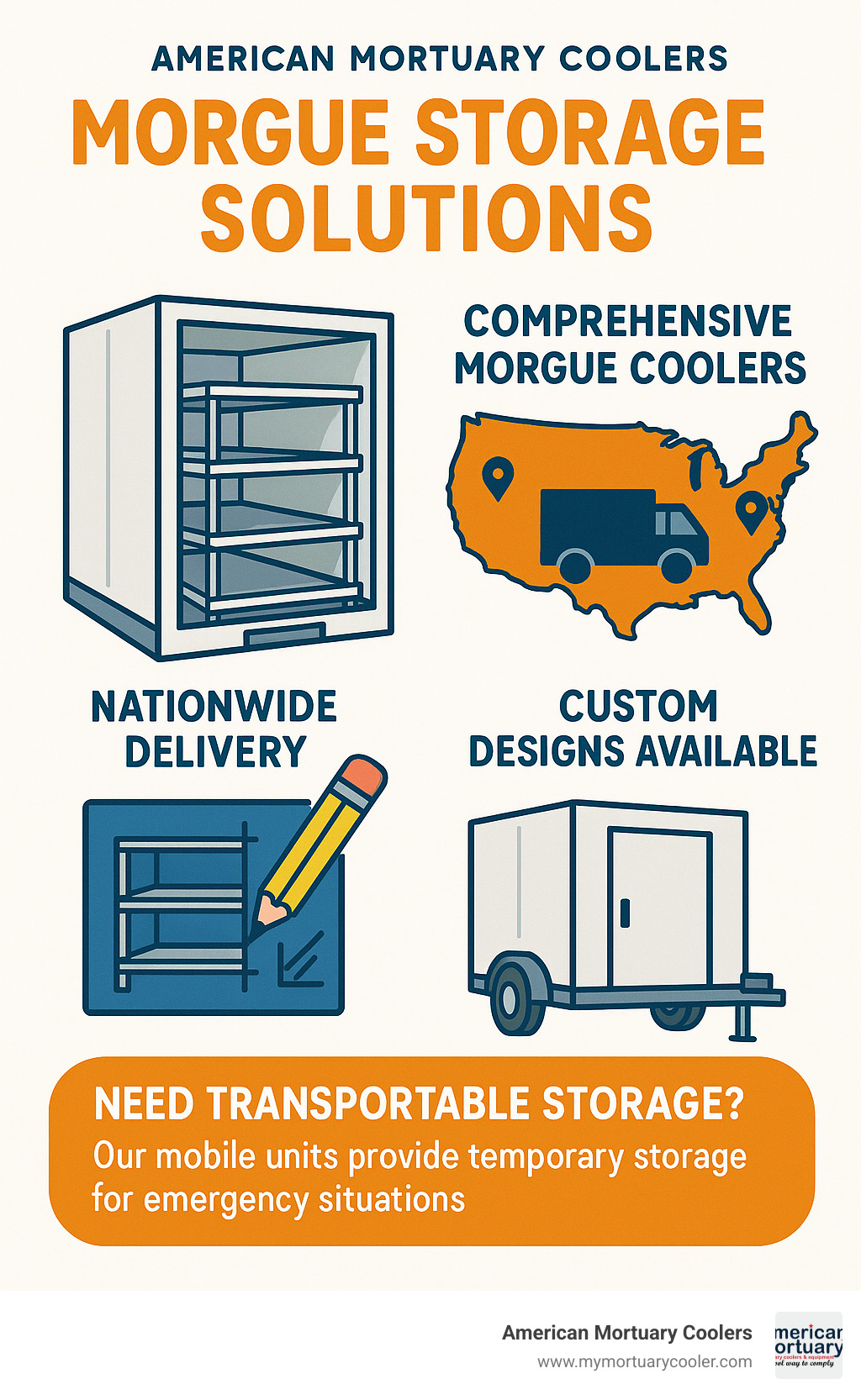
The evolution of morgue storage solutions represents one of the most significant advances in funeral service operations over the past decade. What started as simple refrigerated boxes has transformed into sophisticated systems solving real problems for people working in challenging conditions.
When you can quadruple storage capacity with 4-tier rack systems, reduce staff injuries with ergonomic roller assemblies, and deploy emergency capacity in under 60 seconds, you're investing in better outcomes for everyone involved.
At American Mortuary Coolers, we've worked with facilities across all 48 contiguous states, from small family funeral homes to major metropolitan medical examiner offices. Each installation teaches us about the unique challenges facing modern morgue operations.
Facility managers consistently report how much difference the right storage solution makes to daily operations. The real difference comes from understanding that every facility has unique needs requiring customized solutions.
Whether you need fixed racks for maximum stability, mobile systems for operational flexibility, or emergency-deployable solutions for disaster preparedness, the right combination exists for your situation. Many successful installations combine multiple approaches.
The investment in quality morgue storage pays unexpected dividends. Beyond obvious capacity gains and safety improvements, facilities report better staff morale, improved workflow efficiency, and improved ability to serve communities during difficult times.
Ready to find how the right morgue storage solutions can transform your facility's operations? We're here to help you steer options and design custom solutions addressing your specific challenges. Our Tennessee-based team understands practical realities of morgue operations and delivers durable, custom solutions with direct delivery nationwide.
For detailed guidance on maximizing existing capacity, explore our comprehensive resource on Optimizing Body Cooler Storage Efficiency.
Contact us today for a consultation. Let's discuss how American Mortuary Coolers can help your facility better serve your community with storage solutions prioritizing dignity, safety, and efficiency in equal measure.
















